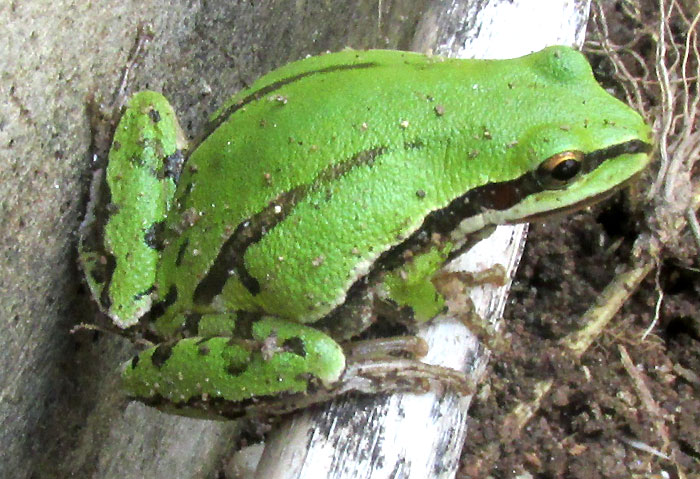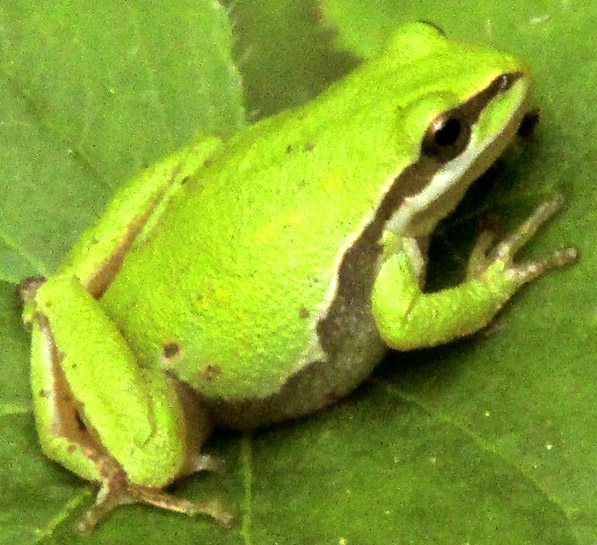Excerpts from Jim Conrad's
Naturalist Newsletter
entry dated August 21, 2022, issued from near Tequisquiapan, elevation about 1,900m (6200 ft), N20.565°, W99.890°, Querétaro state, MÉXICO
MOUNTAIN TREEFROG

In the garden I removed an armload of pulled-up weeds which had been heaped against the wall. The above Mountain Treefrog, HYLA EXIMIA, jumped from where he'd been taking refuge.
I've been hearing this little frog with a big voice for a long time. The rainy season arrived 2 months late this year so he hasn't had much opportunity to call. However, in the backyard I've erected a 1.3 meter-wide (4.3ft), funnel-shaped solar cooker made of thin, reflective aluminum sheeting, and often when I move it, it makes a rumbling sound inspiring the frog to call. I think to him it must sound like thunder. The call, just a few croaks, is a little like a quacking duck.
The little frog was identified by matching pictures on the Querétaro Check List at INaturalist.Org. With the small size and round adhesive pads at toe tips, it was clearly a treefrog. And of the various green frogs on the checklist page, no other treefrog species displays our Mountain Treefrog's black line extending from the snout, through the eye, to the hind leg, plus the black line passing from the rear end to about halfway to the head. Pictures show certain individuals of the species lacking these lines, and I read that the coloration and patterning is very variable in the species, so I'm lucky to have met one ornamented with all the distinctive markings.
The Mountain Treefrog is distributed from the mountains of Arizona and New Mexico in the US south through most of the uplands of Mexico to the Guatemalan border. It's considered a commonly occurring species, though with habitat destruction and climate change nowadays all amphibians are having problems. It's found in the temperate zone of uplands between 900-2900m (2900-9500ft).
With all the house cats roaming the area, I was a little surprised that this backyard hosts what sounds like more than one frog. Maybe that has to do with Mountain Treefrog skin being so toxic that if a human handles one and rubs the eyes afterwards, it can irritate the eyes. Still, it's been shown that Mountain Treefrog survival is five times greater where salamanders are absent, while other threats include invasive, introduced fish, including bass and catfish, and crayfish. Also, human overcollection is a problem.
In 2018, Uriel Hernández-Salinas and others, published a detailed life history of Mountain Treefrogs, entitled "Amphibian life history in a temperate environment of the Mexican Plateau: dimorphism, phenology and trophic ecology of a hylid frog, Hyla eximia (=Dryophytes eximius)." In that fine study I read that our frog mainly eats beetles, fly-related species, or Diptera, true bugs and spiders. The researchers also found a "significant abundance of plant material" in their stomachs, suggesting a highly specialized feeding behavior. Interestingly, the diets of males and females are similar but differ in some ways.
In a 2016 study by W.E. Duellman and others entitled "Phylogenetics, classification, and biogeography of the treefrogs (Amphibia: Anura: Arboranae)," it was made clear that most Old World treefrogs in the genus Hyla are sufficiently different genetically from our New World and eastern Asia ones that the two groups, or clades, should be considered different genera. That study switched our American species of Hyla to the genus Dryophytes.
However, many zoologists in the New World don't like giving up our traditional Hyla species, especially because many of our most common and best known species belong to Hyla. Now in 2022 it looks like most American researchers are insisting on keeping Hyla, but a fair percentage have made a Dryophytes of our otherwise Hyla frogs. The Amphibiaweb.Org website explains their continuing use of Hyla as "... thus stabilizing traditional taxonomy."
Entry dated November 9, 2023, from notes taken near Cascadas de La Piedad waterfall 3kms NW of the community of San Pablo, municipality of Almeaco de Bonfil; in canyon of La Piedad below the falls; N20.1017°, W100.0041°, elevation 2360 meters (7750ft); extreme southern Querétaro state, MÉXICO
MOUNTAIN TREEFROG, FEWER BLACK MARKINGS

This one clung unmoving to a large leaf in deep shadows near trickling water issuing from the canyon wall.